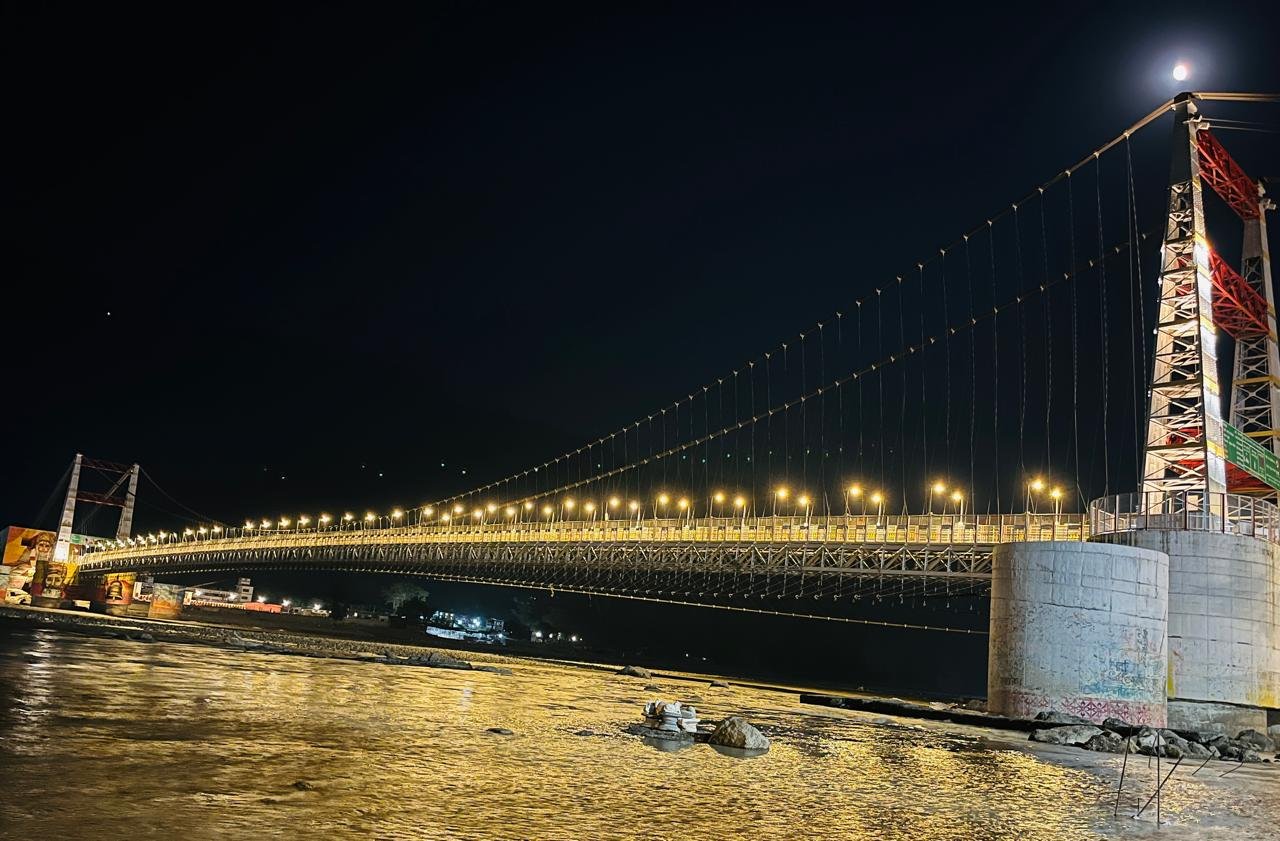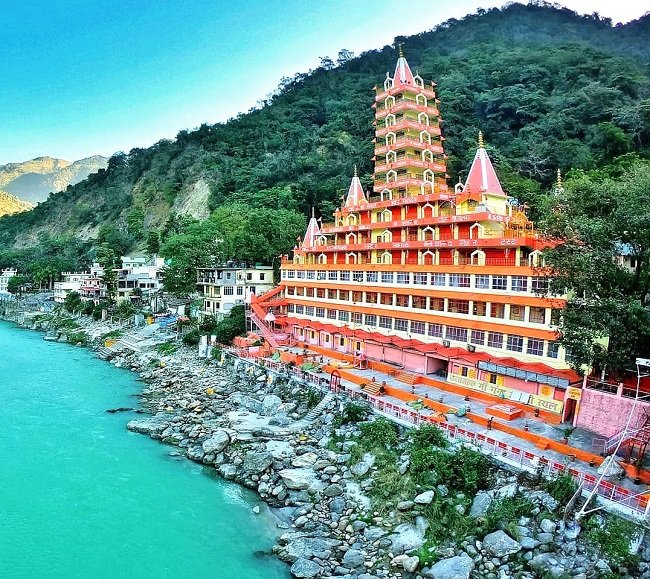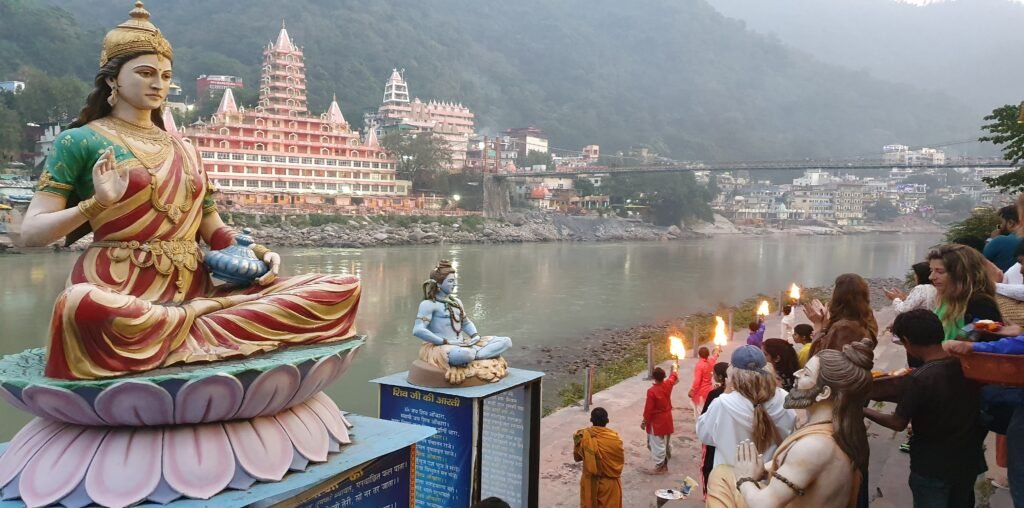
About Rishikesh
Rishikesh is a town in the Dehradun District of Uttarakhand, India, located 409 meters above sea level in the foothills of the Garhwal Himalayan Range. It is surrounded by the Shivalik hills, adding to its scenic beauty. The town is 35 km away from Haridwar, 90 km from Mussoorie, 25 km from Jolly Grant Airport in Dehradun, and 240 km from New Delhi. Rishikesh is known for its spiritual atmosphere and is a popular spot for yoga, meditation, and adventure activities like river rafting. People from all over the world visit Rishikesh to enjoy its peaceful environment and natural surroundings, making it a favorite destination for relaxation and spiritual growth. Also Known as the “abode of sages,” Rishikesh is a spiritual hub, filled with ashrams and globally recognized as the Yoga Capital of the World.
Rishikesh offers breathtaking views of hills covered in dense forests and is home to the meeting point of the River Ganges and Chandrabhaga. The most captivating feature of Rishikesh is the sacred River Ganges, flowing swiftly through the town. For centuries, this peaceful spot has drawn yogis, rishis, sages, and sannyasis, who come here to practice yoga and meditation. Known as the “abode of sages,” Rishikesh is a spiritual hub, filled with ashrams and globally recognized as the
Yoga Capital of the World.
Each year in March, Rishikesh hosts the International Yoga Festival, a week-long celebration that draws yoga enthusiasts from around the world. The town is also known as the gateway to the Char Dham—four significant temples in the Himalayas: Kedarnath, Badrinath, Gangotri, and Yamunotri. Thousands of pilgrims visit annually to seek spiritual peace, practice yoga, enjoy adventure activities, or take a holy dip in the Ganges for salvation. Notable visitors have included celebrities like the Beatles and Kate Winslet, who were inspired by Rishikesh’s serene environment. It is believed that meditating here or bathing in the Ganges can lead to moksha (liberation from the cycle of life and death).
Rishikesh has also become an adventure hotspot, attracting tourists for activities like rafting, trekking, camping, and bungee jumping. It’s known as the white-water rafting capital of India. The town is always bustling with tourists and is home to large ashrams, yoga centers, and places offering Ayurvedic massages and astrology services.
Two iconic suspension bridges, Ram Jhula and Lakshman Jhula, play a crucial role in the daily life of the town. These bridges are named after Lord Ram and his brother Lakshman, who, according to mythology, crossed the Ganges at Rishikesh on their journey to the mountains. The town is divided into different areas such as Ram Jhula, Lakshman Jhula, Muni Ki Reti, Tapovan, and Swarg Ashram.
Visitors can cross the river by walking across Ram Jhula or taking a shared boat ride. Both sides of the bridge are lined with shops selling clothes, holy beads, gemstones, Ayurvedic products, and yoga and meditation class information. The Swarg Ashram side is home to large ashrams like Parmarth Niketan, Swarg Ashram, and Gita Bhawan, while temples greet visitors with intricate carvings and sacred music.
In the evening, the Ganga Aarti (ceremony) takes place at Parmarth Niketan and Triveni Ghat, where priests chant Vedic hymns, accompanied by clapping hands and drumbeats. Hundreds gather to witness the ceremony, offering floating leaf bowls filled with flowers and lamps to the River Ganges. The sight of the flickering lamps on the water and the spiritual atmosphere leaves a lasting impression on visitors, including those from abroad who may not understand the Vedic hymns but are still captivated by the sacred experience.
Rishikesh history
In ancient times, the region known today as Garhwal was called Kedarkhand, as mentioned in the Skanda Purana. According to this scripture, the area was named Kubjamrak because Lord Vishnu appeared to the sage Raibhya Rishi beneath a mango tree. The sage chose this location for his intense penance (tapasya), and Lord Vishnu, pleased with his dedication, manifested as “Hrishikesh.” The name “Hrishikesh” comes from two Sanskrit words: “Hrishik,” meaning senses, and “esh,” meaning master or lord. Hence, Hrishikesh translates to “Lord of the Senses.”
The Sthala Purana describes Raibhya Rishi’s deep connection with the place, where he transformed into a form resembling dense, matted locks of plants. In honor of his penance and the divine qualities he exhibited, the area became known as Rishi Kesha or Rishikesh—meaning the “hair of the sage.” According to the Skanda Purana, Lord Vishnu blessed Raibhya Rishi, stating that the location would be recognized for his supreme control over the senses and named after Hrishikesha (Master of the Senses).
Rishikesh is also linked to the tale of Lord Vishnu defeating the demon Madhu. In the Ramayana, it is said that Lord Ram performed penance in this area after defeating the demon Ravana. His brother, Lakshmana, crossed the river on a jute bridge, which was later replaced by an iron suspension bridge in 1889, known as Lakshman Jhula. This bridge was damaged during a flood in 1924 and was subsequently replaced by a newer structure.
Additionally, legends tell of Lord Agni (the God of Fire) performing penance for Lord Shiva. After the Samudra Manthan (churning of the ocean), Lord Shiva consumed the poison Halahala to save the world, and this event is commemorated at the Nilkanth Mahadev Temple in Rishikesh.
The region has seen various rulers throughout history. Kunind was the first to govern, followed by the Shaka and Naga Kings. In 1398, Vatsraj ruled, and Ajaypal was the king from 1493 to 1500. From 1804 to 1815, the Gorkhas held power, but in 1815, the area came under the control of the East India Company. After India’s independence, Rishikesh became part of Uttar Pradesh. In November 2000, the region became part of the new state Uttaranchal, which was renamed Uttarakhand in 2007.
In 1880, Swami Danaraj Giri founded the Kailash Ashram, and Swami Sivananda (1887–1963), the founder of the Divine Life Society, lived in Muni Ki Reti for three decades. The renowned Parmarth Niketan Ashram was established by Swami Shukdevanandji. Rishikesh gained international fame when The Beatles visited in the 1960s to study yoga, a legacy that helped the town earn its title as the “Yoga Capital of the World.”
Attractions in Rishikesh

Triveni Ghat: Triveni Ghat is the largest bathing ghat in Rishikesh, located close to the main market. This ghat offers stunning views of the mountains and river. The name “Triveni” originates from the belief that it is the confluence of three rivers: the Ganga, Yamuna, and the mythical Saraswati. Due to this sacred convergence, it is considered a holy spot for bathing. A ghat typically consists of steps leading down to the river, allowing people to access the water for religious purposes. Every evening, the Ganga Aarti (worship of the Ganga River) takes place here (5 PM in winter, 6 PM in summer), drawing large crowds. It is a peaceful spot to sit by the riverbank, enjoy the mountain views, and feel the refreshing breeze. Triveni Ghat is located only about 100 meters from the main market. There’s also a small Shani Mandir nearby.
Lakshman Jhula: A large iron suspension bridge crossing the Ganga, located 4.5 km from Rishikesh. According to legend, Lakshman (brother of Lord Ram) crossed the river here using a jute rope. The current bridge, constructed in 1929, replaced an older one that was damaged by flooding in 1924. Lakshman Jhula is a hub for tourists, known for its shopping and activities like rafting. Both sides of the bridge are lined with numerous shops offering various items. The Lakshman Temple and the Tera Manzil Temple are also located nearby. The bridge provides a magnificent view of the river and the surrounding area. Although mainly for pedestrians, it is also used by motorbikes.
Ram Jhula: Another suspension bridge similar to Lakshman Jhula, connecting Sivananda Ashram and Swarg Ashram, also known as Ram Jhula or Sivananda Jhula. A boat service is also available for crossing the river here. Like Lakshman Jhula, this bridge is lined with shops on both sides, offering various goods. At one end, you’ll find Sivananda Ashram, Yog Niketan, and Omkarnanda Ashram, while the other end houses Swarg Ashram, Gita Bhawan, and Parmarth Niketan Ashram. Though primarily a pedestrian bridge, bikes also cross here.
Parmarth Niketan: Located in the Swarg Ashram area, Parmarth Niketan Ashram offers accommodations for both devotees and tourists. The ashram is adorned with numerous religious statues and hosts the International Yoga Festival annually. It’s a favorite among tourists for its focus on yoga. Every evening (5 PM in winter, 6 PM in summer), the ashram holds the Ganga Aarti at its ghat, which is a must-see event for visitors.
Neelkanth Mahadev Temple: Situated at an elevation of 1,325 meters and 31 km from Rishikesh, this temple is dedicated to Lord Shiva. According to mythology, Lord Shiva meditated here after drinking the poison Halahala during the churning of the ocean (Samudra Manthan), which turned his throat blue—hence the name Neelkanth (Blue Throat). Thousands of devotees visit the temple during Shivratri and Kanwar Mela. The temple is accessible via both trekking paths and road from Swarg Ashram. Temple hours are from 5 AM to 1 PM and 4 PM to 9 PM.
Sivananda Ashram: Also known as the Divine Life Society, Sivananda Ashram is located near Ram Jhula. It was founded by Swami Sivananda, who lived here for over three decades. The ashram offers activities such as yoga, meditation, and operates a hospital. There are guest accommodations, and the ashram has halls for meditation, yoga, and music. It remains one of Rishikesh’s most well-known spiritual centers.
Bharat Mandir: This ancient temple, located in the heart of Rishikesh, near the main market, is dedicated to Lord Vishnu. According to legend, Raibhya Rishi performed penance here, and Lord Vishnu appeared to bless him. The temple also features a small museum. Bharat Mandir is easy to access from the Chandrabhaga Bridge. Temple timings are 5 AM to 11 AM and 3 PM to 9 PM.
Gita Bhawan: Located in the Swarg Ashram area, Gita Bhawan is a large ashram complex that offers over 300 rooms at affordable prices for tourists. Inside, there’s a temple, with murals depicting scenes from Lord Krishna’s life. Passages from the Bhagavad Gita are inscribed on the ashram’s walls. Additionally, there are shops for clothing, books, Ayurvedic medicines, and a restaurant.
Swarg Ashram: This area, between Lakshman Jhula and Rishikesh, is well-known for its many ashrams, serene surroundings, and a lifestyle focused on health and spirituality. There are also many shops to explore. You can access the area by walking across Ram Jhula or by road through Beraj. Notable spots include Parmarth Niketan, Gita Bhawan, and Bhootnath Temple.
Tera Manzil Temple: This 13-story temple, located near Lakshman Jhula, features numerous small temples on each floor, dedicated to different deities. The view from the top is breathtaking. The temple is also referred to as the Trayambakeshwar Temple or Kailashanand Mission Trust.
Beatles Ashram: This ashram, located in the Swarg Ashram area, was abandoned in 1997 and is now managed by the forest department. It still has some remnants of its former glory, such as meditation cells and lecture halls. The Beatles stayed here in February 1968 to practice yoga and meditation, bringing global attention to Rishikesh as a yoga destination.
Other Places to Visit in Rishikesh: Notable sites include the Iskcon Temple, Astha Path, Bhootnath Temple, Raghunath Temple, Rishikund, Swarga Niwas Temple, Marine Drive, Rishikesh Main Market, Chandreshwar Mahadev Temple, Goa Beach, Kunjapuri Devi Temple, Vindyavasini Temple, Veer Bhadra Temple, Patna Waterfall, Neer Waterfall, Secret Waterfall, and Jungle Safari.
How to Reach Rishikesh
-
By Bus: Rishikesh is well-connected to major Indian cities by road. It is approximately 245 km from New Delhi, 27 km from Haridwar, and 35 km from Dehradun. Government buses operate regularly from Delhi, Haridwar, and Dehradun to Rishikesh. The bus journey from Delhi typically takes around 4 to 5 hours, while Haridwar to Rishikesh is just a 30-minute drive.
-
By Air: The nearest airport to Rishikesh is Dehradun’s Jolly Grant Airport, about 25 km away. There are daily flights from New Delhi to Dehradun, and Major airlines provide regular services from Delhi to Dehradun.
-
By Train: Rishikesh has a small railway station with limited services. However, Haridwar Railway Station, located 35 km away, is a major hub. From there, you can take a taxi or auto-rickshaw to reach Rishikesh. Trains are popular options from New Delhi to Haridwar or Rishikesh.
Note: The information provided here is frequently updated, and any errors are unintentional. Feel free to inform us if you spot inaccuracies.


